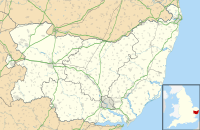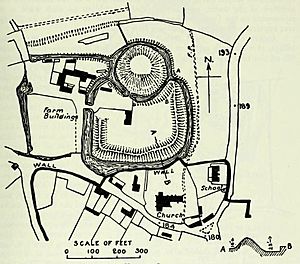Haughley Castle facts for kids
Quick facts for kids Haughley Castle |
|
|---|---|
| Suffolk, England | |

Part of the moat of Haughley Castle
|
|
| Coordinates | 52°13′21″N 0°57′48″E / 52.2226°N 0.9633°E |
| Type | Motte and bailey |
| Site history | |
| Events | Revolt of 1173-4 |
Haughley Castle was an important medieval castle. It was located in the village of Haughley in Suffolk, England. This is about 4 kilometers (2.5 miles) north-west of Stowmarket. Experts like J. Wall say it's "the most perfect earthwork of its kind" in the area. Another historian, R. Allen Brown, called it "one of the most important" castles in East Anglia.
Contents
Haughley Castle: A Medieval Fortress
What Was Haughley Castle Like?
Haughley Castle was built in the late 11th century. It was created by a powerful lord named Hugh de Montfort. The castle was a "motte and bailey" design. This means it had a large mound (the motte) and a walled courtyard (the bailey).
The motte at Haughley was very big. It was about 64 meters (210 feet) wide at its base. Some experts think it was around 24 meters (80 feet) tall. However, others believe it was closer to 12 meters (40 feet) high. The bailey was shaped like a rectangle. It measured about 119 meters (390 feet) by 91 meters (300 feet). The main entrance was on the west side.
Both the motte and the bailey were protected by a deep ditch. This ditch was filled with water from a nearby stream. This created a wet moat around the castle. Early studies suggested there might have been a stone "shell keep" on top of the motte. A shell keep was a circular stone wall. However, today, you can no longer see any signs of these foundations.
Who Owned Haughley Castle?
Haughley Castle was the main castle, or caput, of the "Honour of Haughley." An "honour" was a large area of land. It was controlled by a powerful lord. The owner of Haughley Castle had a special duty. They had to provide soldiers and knights to the constable of Dover Castle. This was called "castle-guard".
Hugh de Montfort became a monk in 1088. The castle then stayed in his family for many years. Later, around the end of King Stephen's reign, the king gave the castle away. He gave it to Henry of Essex, who was one of his supporters.
The Great Revolt of 1173
By the late 12th century, the Bigod family was very powerful in Suffolk. They were the Earl of Norfolk. They often disagreed with the king about who controlled the region.
When Henry II became king, Henry d'Essex lost his favor. Henry d'Essex was accused of being a coward during a battle in Wales in 1157. Because of this, King Henry II took Haughley Castle in 1163. By the mid-1170s, the king's men controlled the castle. Ralph de Broc and 30 soldiers guarded it.
In 1173, a big conflict broke out. This was the revolt of Henry II's sons. The Bigod family's friend, Robert de Beaumont, the Earl of Leicester, joined the revolt. He landed on the coast of East Anglia. Then, he marched to Haughley Castle and attacked it.
Ralph de Broc surrendered the castle to Robert's forces. The castle was then burned down. Even though the revolt failed later, Haughley Castle was never fully rebuilt. A manor house was built inside the inner bailey. The outer bailey slowly filled up with other buildings. The last parts of the old tower were removed in 1760. Today, you can still see the circular foundations of the tower. They are over 2.4 meters (eight feet) thick.
Today, Haughley Castle is a scheduled monument. This means it is a nationally important historical site. It is protected by law.



